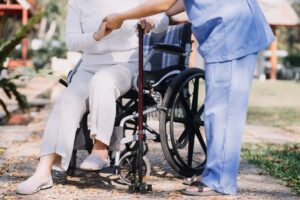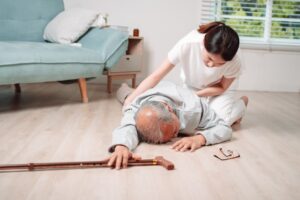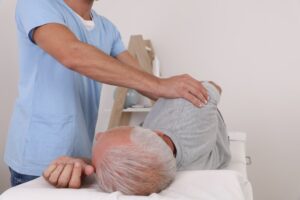When to Suspect Neglect After a Nursing Home Fall
Abuse and Neglect, Nursing Home AbuseWhen a loved one residing in a nursing home experiences a fall, it can be challenging to determine whether neglect played a role in the incident. While falls can sometimes happen due to medical conditions or accidents, it is important to be cautious and aware of the signs of neglect that may have contributed to the fall. Neglect can manifest in various ways, such as inadequate staff supervision, failure to follow safety protocols, lack of assistive devices, or not addressing fall risk assessments.
If you suspect that neglect may have been a factor in your loved one’s fall, be sure to consult with a legal professional with experience in nursing home negligence cases. They can provide guidance, advocate for your loved one’s rights, and help determine whether legal action is warranted. Contact an experienced nursing home neglect attorney near you to discuss your situation and ensure your loved one receives the care and justice they deserve.
Signs of Neglect After a Nursing Home Fall
After a nursing home fall, sure signs may indicate neglect was a contributing factor. You should always be vigilant and attentive to these signs to protect your loved one’s well-being and seek justice if necessary. Here are some common signs to watch out for:
Inadequate Staff Supervision and Training
One key sign of neglect after a nursing home fall is inadequate staff supervision. Nursing homes have a duty to ensure that residents are properly supervised and attended to. It may indicate neglect if your loved one experienced a fall due to a lack of staff oversight. Insufficient staffing levels can lead to delays in responding to call lights, leaving residents unattended for prolonged periods, increasing the risk of falls.
Additionally, if staff members are not properly trained in fall prevention techniques or do not have the necessary knowledge to identify potential hazards, residents’ safety may be compromised.
Failure to Follow Safety Protocols
Nursing homes should have established safety protocols in place to prevent falls and mitigate risks. These protocols may include regular risk assessments, implementing assistive devices, and creating a safe environment for residents. If a nursing home fails to follow these safety protocols and your loved one experiences a fall as a result, it may be a sign of neglect.
Lack of Assistive Devices

Assistive devices, such as grab bars, walkers, or wheelchairs, are necessary for residents with mobility issues or are at risk of falling. If your loved one’s fall occurred due to a lack of access to these devices or a failure to provide them when needed, it can indicate neglect. Nursing homes have a responsibility to ensure that residents have the necessary assistive devices to maintain their safety and prevent falls.
Not Addressing Fall Risk Assessments
Before your loved one enters a nursing home, a fall risk assessment should be conducted to evaluate their vulnerability to falling. This assessment helps identify potential hazards and develop a care plan to mitigate the risk of falls. If a nursing home fails to address the fall risk assessment or neglects its recommendations, leading to your loved one’s fall, it may indicate negligence on the part of the facility.
Psychological or Emotional Changes
Neglect in nursing homes can also have psychological and emotional effects on residents. After a fall, pay attention to any changes in your loved one’s behavior, mood, or overall well-being. Neglect can cause feelings of isolation, anxiety, and depression, leading to a decline in their mental health. These changes may indicate that neglect played a significant role in the fall.
Inadequate Safety Measures
Nursing homes are responsible for implementing and maintaining appropriate safety measures to prevent falls. This includes ensuring that handrails are in place, floors are free from hazards, and residents can access mobility aids such as walkers or canes. If a nursing home fails to implement these safety measures or neglects to maintain them, it may indicate a disregard for the safety of its residents.
Lack of Documentation
Proper documentation is necessary for nursing homes to track residents’ falls and the actions taken to prevent future incidents. If there is a lack of documentation regarding preventative measures or a resident’s fall, it can be a sign that the nursing home is not prioritizing its residents’ safety or neglecting its duty to provide proper care.
Unexplained Injuries
When a nursing home resident falls, it is crucial to determine the cause and identify any resulting injuries. Sometimes, injuries sustained during a fall may be a result of neglect. For example, if a resident falls due to a hazard that should have been addressed by the nursing home, such as a wet floor or a loose handrail, their injuries may indicate neglectful care.
Environmental Hazards
Neglect can also be indicated by the presence of hazards in the nursing home environment. These hazards can include wet or slippery floors, inadequate lighting, or malfunctioning equipment. If these hazards are not promptly addressed, it suggests a lack of attention to resident safety.
Delayed Medical Attention
Residents should receive prompt medical attention after a fall. If staff members fail to respond quickly or do not inform the family about the incident, it can suggest neglect. Timely medical intervention is required to assess injuries, provide appropriate treatment, and prevent further complications.
High Number of Falls in the Facility
If a nursing home has a high number of falls reported within a specific time period, it may suggest a pattern of neglect. Multiple falls indicate a failure to implement effective fall prevention strategies or a lack of attention to residents’ safety, which raises concerns about the quality of care the nursing home provides.
Risk Factors for Nursing Home Falls

Understanding the common risk factors for nursing home falls is imperative in identifying potential neglect. Certain factors increase the likelihood of falls and can help families determine whether neglect may have been a contributing factor.
Age-Related Decline
As individuals age, their balance, physical strength, and mobility may decline. This makes them more susceptible to falls, especially if they have underlying health issues. Neglect may be indicated if the nursing home fails to address these age-related declines with appropriate care and support.
Medical Conditions
Residents with medical conditions such as Parkinson’s disease, dementia, or arthritis are at a higher risk of falling. Nursing homes should be aware of these conditions and implement measures to prevent falls. Neglect can be suspected if proper care and attention is not given to residents with underlying medical conditions.
Medication and Side Effects
Some medications can cause dizziness, drowsiness, or decreased cognitive function, increasing the risk of falls. Nursing homes should regularly review residents’ medication regimens and monitor for side effects. Neglect may be suspected if residents are not properly monitored for medication-related fall risks.
Environmental Factors
Poorly designed or maintained environments can contribute to falls. Examples include inadequate handrails, poorly lit hallways, or cluttered common areas. Neglect may be indicated if these environmental risk factors are not addressed promptly and effectively.
The Importance of Documentation in Nursing Home Falls
Accurate and thorough documentation is essential when it comes to nursing home falls. Documentation is valuable evidence in identifying neglect and holding the responsible parties accountable.
Incident Reports
After a fall, nursing homes should document the incident in an incident report. These reports should include details about the fall, the time and location, any witnesses, and the actions taken by staff members. If incident reports are incomplete, vague, or missing altogether, it may indicate an attempt to cover up neglect.
Medical Records
Proper documentation in medical records is necessary to assess the extent of injuries and provide appropriate treatment. Additionally, medical records should include information about the resident’s medical history, any pre-existing conditions, and medications. Thorough medical records can help determine whether neglect played a role in the fall.
Staff Shift Logs
Nursing homes should maintain records of staffing levels and individual staff assignments. These shift logs can provide insight into whether there was adequate supervision and assistance at the time of the fall. Inconsistencies or gaps in the shift logs may indicate neglect.
Communication Logs
Documentation of communication between staff members, residents, and their families is invaluable. This includes documenting any concerns raised by residents or their families about fall risks and the nursing home’s response. Properly documented communication can help reveal patterns of neglect or lack of action.
How to Respond to Suspected Neglect After a Nursing Home Fall
If neglect is suspected after a nursing home fall, take immediate action to protect the rights and well-being of your loved one. You will want to follow these steps:

- Seek Medical Attention: Ensure that the resident receives appropriate medical care for their injuries and a thorough evaluation of their condition.
- Document and Preserve Evidence: Collect and preserve any evidence related to the fall, including photographs of the environment, copies of medical records, incident reports, and any relevant communication logs.
- Report the Incident: Notify the nursing home administration about your concerns and file a formal complaint. Document the details of your conversation and any actions taken by the facility.
- Consult with an Attorney: Contact an experienced nursing home neglect attorney to discuss your case and explore your legal options. They can guide you through the process and help protect your rights.
Legal Options for Victims of Neglect After a Nursing Home Fall
Victims of neglect in nursing home falls and their families have legal options to seek justice and compensation for their injuries and losses. These options may include:
Filing a Lawsuit
A nursing home neglect lawsuit can hold the facility accountable for their negligent actions or lack of proper care. Compensation may be sought for medical expenses, pain and suffering, emotional distress, and other damages.
Pursuing an Insurance Claim
If the nursing home has liability insurance, a claim can be filed with the insurance company. An attorney can handle negotiations with the insurance company to secure fair compensation.
Seeking Compensation Through Mediation or Arbitration
In some cases, alternative dispute resolution methods such as mediation or arbitration can be pursued to resolve the matter outside of court. A nursing home neglect lawyer can guide you through these processes and advocate for your best interests.
Reporting to State Regulatory Agencies
If neglect is suspected, it is important to report the incident to the appropriate state regulatory agency. They can conduct investigations and take legal action against the nursing home if violations are found.
Seeking Legal Assistance in Cases of Neglect After a Nursing Home Fall

When dealing with neglect after a nursing home fall, it’s in your best interest to seek the assistance of a qualified nursing home neglect lawyer. Here’s how to find and work with an attorney in these cases:
Research and Gather Information
Use online resources, referrals, and personal recommendations to identify attorneys experienced in nursing home neglect cases. Focus on finding attorneys with a track record of success in these types of cases.
Schedule Consultations
Reach out to potential attorneys and schedule initial consultations. Take this opportunity to ask questions, discuss your concerns, and evaluate their knowledge and experience in nursing home neglect cases.
Assess Experience and Skill
During consultations, inquire about the attorney’s experience handling nursing home neglect cases. Ask about their success rate, their familiarity with relevant laws, and their approach to handling such cases.
Discuss Fees and Payment Structure
Clarify the lawyers fee structure, including whether they work on a contingency basis (where they only get paid if you receive compensation) or if they charge a flat fee or hourly rate. Make sure you understand and are comfortable with the agreement before proceeding.
Retain an Attorney
Once you have identified a qualified nursing home neglect lawyer who meets your needs, formalize the attorney-client relationship by signing an engagement agreement. This will outline the terms of their representation and your obligations as the client.
Remember, finding the right attorney can significantly impact the outcome of your case and help protect your loved one’s rights. Take the time to thoroughly research and select an attorney who focuses on nursing home neglect cases and has a proven track record of success.
Contact a Nursing Home Neglect Attorney Near You Today
If you suspect neglect after a nursing home fall, seek legal assistance to protect your loved one’s rights. Contact an attorney near you with experience in nursing home neglect and abuse to discuss your case in detail and determine the best course of action. Your loved one deserves justice and compensation for their injuries and suffering. Don’t delay; reach out to a skilled personal injury lawyer today.
Nathan Hughey, an attorney and fourth-generation South Carolinian, founded Hughey Law Firm in 2007. Before that, he spent five years defending nursing homes and insurance companies. Leveraging his experience, he now advocates for those injured or wronged by such entities, securing over $220 million in verdicts and settlements.
